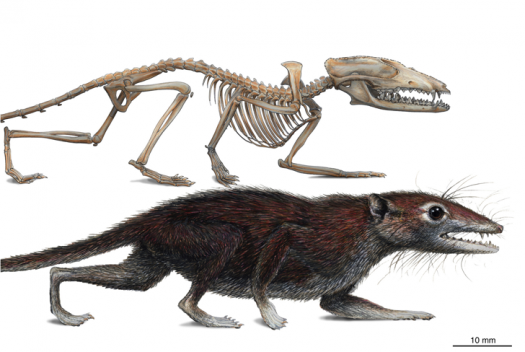It’s been a big month for science-related news in many fields. From astronomists’* astronomers’ discovery of blinged-out planet to paleontologists’ fossils from just a blink after the Earth was formed, researchers have unleashed all kinds of awesome new info lately. Here’s a round-up of the biggest recent news and coolest finds:
1. This Ice World Is No Hoth.
The planet found orbiting the 5.7-millisecond pulsar known as PSR J1719-1438 is likely made of diamond, a result of the super-high pressure of the planet, which completes one revolution of its neutron star companion every two hours. The planet is the remaining dead core of a star that was mostly assimilated by the pulsar (as seen in the video above). Interestingly, the star-turned-planet is larger than its pulsar sun–3,000 times larger when measured by size. The system is located about 4,000 light-years from Earth in the constellation of Serpens (The Snake). Read more on Space.com
2. Meet Your New Grandmother, (Almost) Every Mammal!

3. CERN Caught Higgs-less… Again.

Recent reports from LHC research show these numbers from March holding steady.
The theorized Higgs boson is believed to give particles mass and is the keystone to the standard model of physics. Thing is, we haven’t discovered it yet. The so-called God Particle has yet eluded physicists again, a report from research at CERN states. Through all the petabytes of data the LHC has stored and reviewed since March 2010, it is 95% probable that the Higgs boson does not exist within the range of 145 to 466 billion electron volts (GeV). Does this mean Stephen Hawking has won his bet against all of physics? Don’t be so quick to collect, Steve: most Higgs-hunters are glad that this 145-466GeV range has been removed from consideration, since the theory of supersymmetry proposes that the Higgs boson would exist somewhere in the range of 114-145GeV and ideally between 120 and 130 GeV.
“In a sense, these [latest] results from the LHC are not surprising,” [Nobel prize-winner Frank] Wilczek says. “It would have been very embarrassing for supersymmetry and the properties of the particles we know about if the Higgs had been discovered in the range of masses that have [now] been explored.”
Now that we know where the Higgs isn’t, we can continue looking for places it still could be. Should the search reveal that the Higgs boson does not exist, it’s then time to begin testing non-standard models of physics. More details on New Scientist.
4. They’re Even Older than Dirt
A group of micropaleontologists from University of Western Australia and Oxford University have discovered sulfur-breathing bacteria fossils in Australia–the oldest known microfossils and evidence that life formed on the planet very early on. The fossils, found in a 3.4 billion year-old rock, have a regular, cell-like structure and are satisfactorily determined to be of biological origin.
‘At last we have good solid evidence for life over 3.4 billion years ago. It confirms there were bacteria at this time, living without oxygen,’ says Professor Brasier of the Department of Earth Sciences at Oxford.
The chemical composition and the pyrite present in samples show that the microorganisms processed sulfur much in the same way modern bacteria process oxygen–a telling find, as the Earth had not yet formed its heavy layer of oxygen-rich atmosphere. To further stress the importance of this discovery, it’s important to note that 3.4 billion years ago the planet had (geologically speaking) just exited the Late Heavy Bombardment period, adding some weight (though, of course, unsubstantiated) to the theory that life on Earth was planted by wayward asteroids colliding with the surface. The University of Oxford has the full report and more images.
*Bad Staffer needs more sleep, less coffee, and a job writing for Stephen Colbert’s truthiness strategery team.

